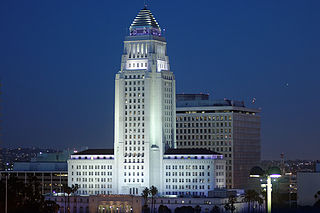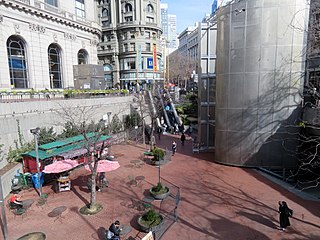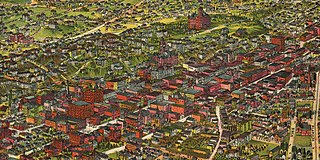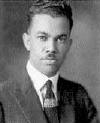
Welton David Becket was an American modern architect who designed many buildings in Los Angeles, California.

Los Angeles City Hall, completed in 1928, is the center of the government of the city of Los Angeles, California, and houses the mayor's office and the meeting chambers and offices of the Los Angeles City Council. It is located in the Civic Center district of downtown Los Angeles in the city block bounded by Main, Temple, First, and Spring streets, which was the heart of the city's central business district during the 1880s and 1890s.

The Civic Center neighborhood of Los Angeles, California, is the administrative core of the City of Los Angeles, County of Los Angeles, and a complex of city, county, state, and federal government offices, buildings, and courthouses. It is located on the site of the former business district of the city during the 1880s and 1890s, since mostly-demolished.

Triforium is a 60-foot high, concrete public art sculpture mounted with 1,494 Venetian glass prisms, light bulbs, and an internal 79-bell carillon located at Fletcher Bowron Square in the Los Angeles Mall at Temple and Main streets in the Civic Center district of Downtown Los Angeles.

Temple Street is a street in the City of Los Angeles, California. The street is an east-west thoroughfare that runs through Downtown Los Angeles parallel to the Hollywood Freeway between Virgil Avenue past Alameda Street to the banks of the Los Angeles River. It was developed as a simple one-block long lane by Jonathan Temple, a mid-19th Century Los Angeles cattle rancher and merchant.
Main Street is a major north–south thoroughfare in Los Angeles, California. It serves as the east–west postal divider for the city and the county as well.

Hill Street is a major north–south thoroughfare in Los Angeles, measuring 4.8 miles (7.7 km) in length. It starts on Martin Luther King, Jr. Boulevard near the campus of USC, and passes north through Downtown Los Angeles, past such landmarks as Pershing Square, the Subway Terminal Building, Angels Flight, Fort Moore and Chinatown. Hill Street merges with the Arroyo Seco Parkway near Dodger Stadium.

Hallidie Plaza is a public square located at the entrance to Powell Street Station on Market Street in the Union Square area of downtown San Francisco, California, United States. Hallidie Plaza was designed jointly by Lawrence Halprin, John Carl Warnecke, and Mario Ciampi and opened in 1973. In 1997, a perforated stainless steel-screened elevator was added to provide access to the plaza and station for disabled people.

Grand Avenue is a major north–south thoroughfare in Los Angeles, California. Lined with museums, concert venues, and theaters, this urban center on Bunker Hill attracts millions of people a year. Grand Park stretches between the Los Angeles City Hall and the Los Angeles Music Center on Grand Avenue. In 2007, a $3 billion Grand Avenue Project was proposed to revive Downtown Los Angeles.

Kenneth Hahn Hall of Administration, formerly the Los Angeles County Hall of Administration, completed 1960, is the seat of the government of the County of Los Angeles, California, and houses the Los Angeles County Board of Supervisors, meeting chambers, and the offices of several County departments. It is located in the Civic Center district of downtown Los Angeles, encompassing a city block bounded by Grand, Temple, Hill, and Grand Park.

Civic Center Plaza, also known as Joseph Alioto Piazza, is the 4.53-acre (1.83 ha) plaza immediately east of San Francisco City Hall in Civic Center, San Francisco, in the U.S. state of California. Civic Center Plaza occupies two blocks bounded by McAllister, Larkin, Grove, and Carlton B. Goodlett, divided into a north block and south block by the former alignment of Fulton Street. The block north of Fulton is built over a three-story parking garage ; the block south of Fulton lies over a former exhibition space, Brooks Hall.

United Nations Plaza is a 2.6-acre (1.1 ha) plaza located on the former alignments of Fulton and Leavenworth Streets—in the block bounded by Market, Hyde, McAllister, and 7th Street—in the Civic Center of San Francisco, California. It is located 1⁄4 mi (0.40 km) east of City Hall and is connected to it by the Fulton Mall and Civic Center Plaza. Public transit access is provided by the BART and Muni Metro stops at the Civic Center/UN Plaza station, which has a station entrance within the plaza itself.
Joseph Young (1919–2007) was an artist well known for his public artwork, which included mosaic murals, stained glass windows, monuments and public sculptures in granite, concrete, and bronze. Over the course of his career Young completed over sixty commissions for civic, church, synagogue and other public spaces, as well as privately collected works in oil, mosaic, ceramics and other media. His largest work is the mosaic West Apse of the Basilica of the National Shrine of the Immaculate Conception in Washington, D.C., entitled "The Woman Clothed With The Sun." Notable works in Los Angeles include the Holocaust Monument, the mosaic bas-relief on the Richard Neutra-desigined Los Angeles County Hall of Records, mosaic panels on the exterior of the UCLA Math Sciences Building, and the Triforium. in Fletcher Bowron Square on the Los Angeles Mall at the Civic Center, Los Angeles.

The late-Victorian-era Downtown of Los Angeles grew year by year, around 1880 centered at the southern end of the Los Angeles Plaza area, and over the next two decades, extending south and west along Main Street, Spring Street, and Broadway towards Third Street. Most of the 19th-century buildings no longer exist, surviving only in the Plaza area or south of Second Street. The rest were demolished to make way for the Civic Center district with City Hall, numerous courthouses, and other municipal, county, state and federal buildings, and Times Mirror Square. This article covers that area, between the Plaza, 3rd St., Los Angeles St., and Broadway, during the period 1880 through the period of demolition (1920s–1950s).

Stanton & Stockwell was a partnership of Jesse Earl Stanton and William Francis Stockwell, two architects active in Southern California during the mid-20th century. Works attributed to them include:
















